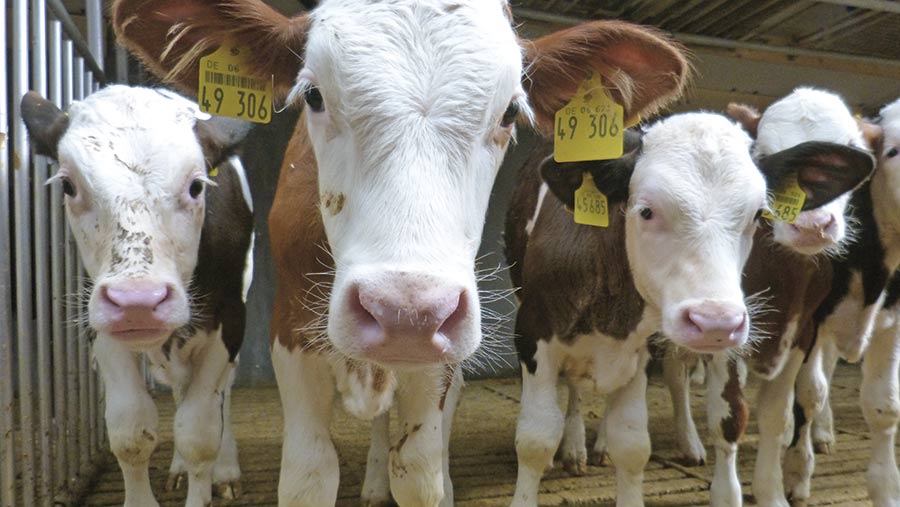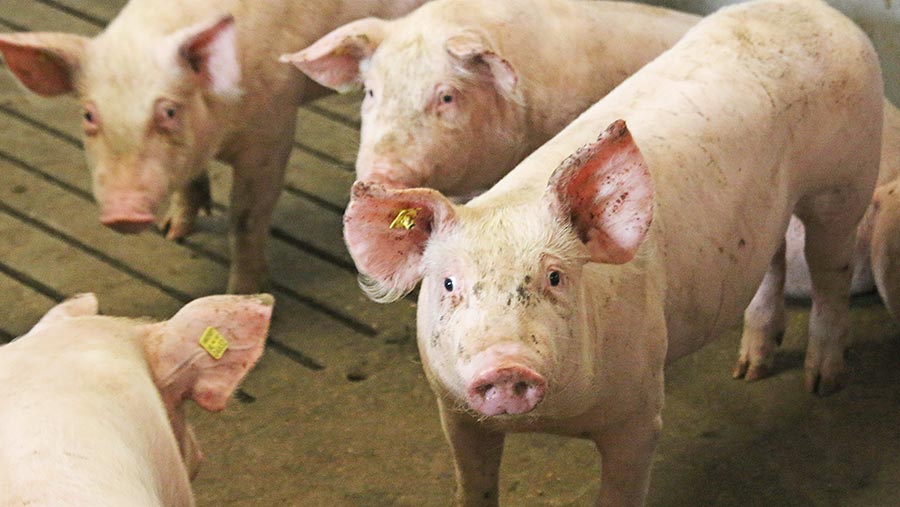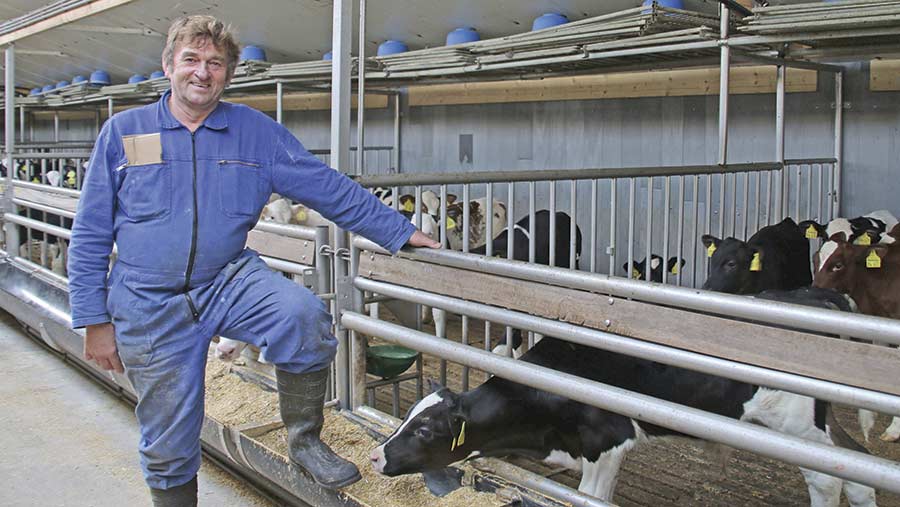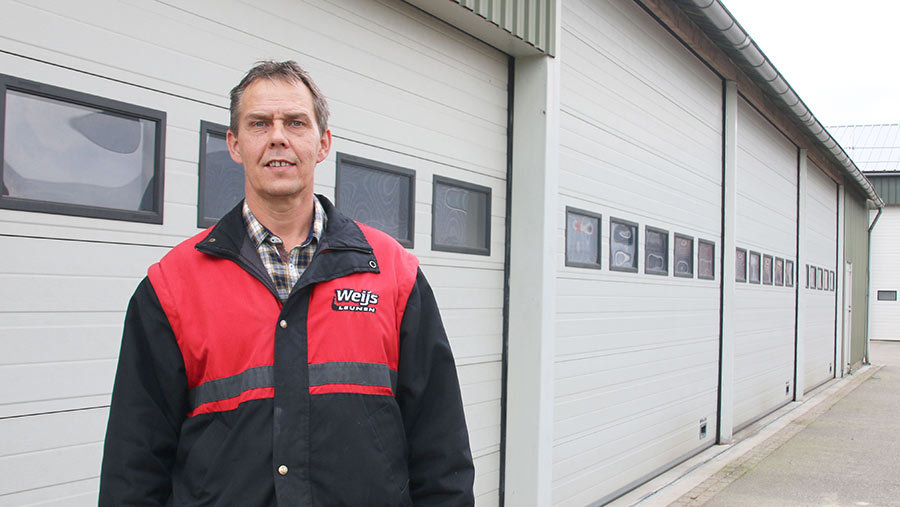How Dutch farmers reduced antibiotics use by 60%
 DO NOT REUSE
DO NOT REUSE Strict regulation has more than halved Dutch antibiotics use in recent years as a new era in farm health planning and probiotics has driven livestock systems.
More frequent veterinary visits, a three-step antibiotics request programme and antibiotics alternatives have been used to maintain productivity and rein in medication.
In addition, “naughty lists” of vet practices not curbing antibiotics use have been published nationally as an incentive to veterinary surgeons to make changes.
See also: Dutch dairy farmers win court appeal over cow cull plan
Dairy veterinary surgeon Erik Boer of Vechtdal Animal Clinic said he is under much greater scrutiny than before.
Farms and vet practices are anonymously classed according to antibiotics use as green (good) amber (needs improvement) and red (bad).
“Most farms are in the green section,” explains Mr Boer. “As a last resort vets face losing their license if they are in the red.
“Mortality has increased on some farms but not as much as perhaps expected. You have to change your mental attitude. Sometimes it would be easier without all the regulations but I do believe in what we are doing, it does get results.”
Achievements – antibiotics reductions
Using 2009 as a comparative year, official Dutch figures have shown a 60% reduction in broilers, a 56% reduction in pigs and a 47% reduction in dairy.
This includes reductions of 99% and 68% in cephalosporins and colistin respectively, which are both on World Organisation for Animal Health and World Health Organization lists of “critically important antibiotics”.
To monitor farms and measure sectors against each other all usage was measured in defined daily dose, as opposed to the miligrams per kilogram method adopted later in the UK.
Rule changes
A range of measures were enforced in 2011 which saw preventative use of antibiotics inhibited and all antibiotics falling under a three-choice rule.

From 2012, farms started getting one-to-one contact with a sole veterinarian who prescribed and delivered antibiotics. Annual health plans were backed up with monthly visits for pig farms and quarterly visits for dairy farms.
March 2014 saw only first-choice antibiotics stocked on farms, group medication only possible after veterinary prescription and second-choice antibiotics use only after laboratory research and an antibiogram.
On-farm changes
A host of antibiotics alternatives have been embraced to replace drugs, in a similar way to how some UK farms have adapted to reduce antibiotics use.
Such alternative techniques have included prebiotics, probiotics and improved farm biosecurity, as well as greater uptake in vaccines.
Many livestock units have embraced probiotics and acids to alter gastrointestinal microbiology (microbiota) to suit “good bacteria” such as lactobacillus and bifidobacterium.
Three antibiotics options
- Antibiotics such sulfonamides, tetracyclines and penicillins are allowed to be stored and administered by farmers but only to a maximum of 15% of animals
- Antibiotics such as beta-lactamases, colistin and aminoglycosides are used to treat up to 5% of stock on veal farms and 10% on dairy and pig units. Antibiograms are often conducted to find out antibiotics sensitivity of the isolated pathogen from the farm
- Individual treatments allowed only following a compulsory antibiogram to use third and fourth-generation cephalosporins and flouroquinalones
Antibiotic glossary
- Acidophobic Bacteria with an intolerance to acidic (low pH) environments, which includes staphylococcus aureus, e coli, clostridia and salmonella.
- Antibiogram A pathogen is isolated from a farm and studied in a lab to see how it reacts to different drugs and treatments.
- Defined daily dose (DDD) A statistical measure of antimicrobial consumption which is useful for comparing and standardising different drugs against each other. DDD factors in differences of strength and quantity of the drug needed.
- Microbiota The community of bacteria living within the gastrointestinal tract and in animals and livestock more generally. Includes bacteria, fungi and viruses.
- Prebiotics Naturally occurring substances fed to promote conditions for helpful “good” bacteria such as bifidobacteria and lactobacillus.
- Probiotics Adding known “good” bacteria to colonise livestock environments and digestive tracts to support a healthy microbiome.
Case study: Kier Bloemert, veal calf contract rearer, Punthorst, Overijssel
Multifaceted plan for gut health

Kier Bloemert
A multi-faceted approach to improving gut health has seen calf rearer Kier Bloemert halve antibiotics use on his veal calf unit without increasing veterinary bills.
Feeding straw to calves from the day they arrive, attention to milk temperature and two plant-based drenches are used to support intestinal health.
One drench containing a mixture of fatty acids, Mojave yucca, mono-propylene glycol and potassium chloride, is fed at 0.25ml twice daily (0.5ml/day) for the first 10 weeks.
Another plant-based product (oregano, cinnamon, anise, lauric acid) is mixed into the two milk feedings the calves get every day for 26 weeks at 1ml a calf a day.
Tetracyclines and pencillins are used when bacteria such as cryptosporidium and coccidiosis start affecting manure consistency and feed conversion rate.
Heating water cheaply to make warm calf milk replacer is vital to the system, explains Mr Bloemert, who has slashed water heating bills from €17 (£15) a calf to €4 (£3.57) a calf by installing a woodchip-biomass boiler.
Such savings are vital when faced with manure disposal bills of €15 (£13.40) a calf.
The result is average growth rates of 1.06kg/day on its mostly Belgian blue, Piedmontese and Montbelliard-sired dairy-cross calves that come from hundreds of German dairy units.
Calves arrive at about 44kg due to government rules stipulating calves can’t leave their mother if they are under 40kg and have to have had two weeks of colostrum.
Mixing milk correctly at a temperature of 46-48C improves intake, says Mr Bloemert, who uses an automated milk feeding trough system.
Farm facts
- Producing 2,700 veal calves each year
- All-in, all-out policy on two 1,350 batches
- Calves delivered at two weeks of age
- Calves fed until 26-28 weeks to produce a 155kg carcass
- No respiratory vaccinations used
- Former pig farm using slatted sheds for rearing
- 1% calf mortality
- No castration, dehorning or weaning
Focus on water cuts drug use

Rene Weijs
Antibiotics use has fallen from more than 10 daily dosage units to three to four units at the finishing unit of René Weijs since 2011.
A two-pronged approach to water quality is helping control disease with no increase in veterinary bills or loss of production.
Water lines are cleaned between batches with a product containing hydrogen peroxide and activated silver.
This helps keep young pigs’ intestines healthy and not loaded with the wrong type of bacteria when they are young and reduces biofilm in the waterlines where bacteria can develop.
Another solution is then added to the water containing a mixture of short chain fatty acids, copper and zinc to lower stomach pH to about 4, which is an antibacterial level for some pathogens.
Certain unwanted bacteria such as e coli, clostridia and salmonella are acidophobic.
Their development is thought to be inhibited by lowering pH.
The solution added to water to combat one of the farm’s main disease concerns – porcine intestinal adenopathy caused by Lawsonia bacteria
Roof vents control temperatures by channelling fresh, cool air through the floor, keeping pig-level temperatures about 10C.
Abattoir scores on livers and lungs are considerably better than the national average, with some scores at 5% compared with the Dutch average of 20%.
Wet-dry feeding achieves 850-900g of growth a day at 2.35kg of feed to 1kg of bodyweight gained, with boars finishing six to seven days before young females.
The farm’s health plan vaccinates against circovirus and oxytetracycline is the most often used antibiotics.
Farm facts
- 3,200-head finishing unit
- Pigs arrive at 11 weeks old at 27kg
- Pigs finished at 120-125kg in 110 days
- 3.5% monthly mortality (2% is due to porcine intestinal adenopathy)
- Topigs 20 sow line and Tempo Grow boar
- Tails are docked no boars are castrated
Case study: Tiny Schepers, CEO of Heihoef Dutch Quality Pork, Neunen, Eindhoven
Vaccination increase and water checks reap benefits

Tiny Schepers
Acidifying water and upping vaccinations has cut antibiotics by 90% in weaners and 10% in the sow herd at the farm of Tiny Schepers, Neunen.
Vet bills have doubled since 2009, however, which is mostly due to increasing the number of piglet vaccinations.
In 2009, the farm only vaccinated piglets for (porcine reproductive and respiratory syndrome (PRRS)) and in 2010 the farm only vaccinated for mycoplasma.
Now all piglets are vaccinated for PRRS mycoplasma and circovirus. Sows received seven vaccinations (PRRS, influenza, rotavirus, parovirus, erysipela, e coli and clostridial and e coli for neonatal diarrhoea).
A concerted effort has been made to avoid mixing litters to reduce stress and risk of disease transmission.
Cross-fostering on the second day of the piglet’s life has stopped.
Furthermore, sheds are now single purpose, while before gestating sows and weaners were kept in separate parts of the same shed.
Annual water quality checks ensure pigs are accessing clean water from hygienic water lines.
This is reinforced by using Aquaclean to manage bacteria and biofilm in water lines.
Higher veterinary bills cover the cost of vet visits every three to four weeks as part.
Farms are rated on environment, water, ventilation and light out of 10.
Reducing antibiotics is an important achievement for Mr Schepers who has developed his own pork brand.
Farm facts
- 4,000 sow unit rearing 4,000 weaners on site
- Retailing supermarket and butcher pork
- Producing 31-32 pigs a sow a year
- Sow replacement rate 7-14%
- Part of the Hoevenaer and Heyde Hoeve brands
- Conception rates at first service 44-45% and recently up to 60%
Pig diseases A-Z
Check out the Pig Health tool from Pig Progress. It can help you identify, prevent and treat a huge range of pig diseases and health issues. Find a disease now.

